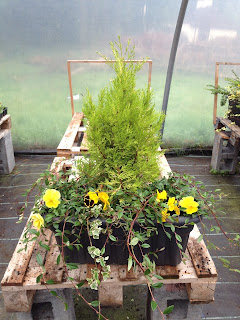There are plants for every location, soil type and climate
so it’s only a matter of choosing the right plant for the right location. Wind
often can be one of those factors that cause problems in the garden. Sometimes
we can reduce the effect of wind by wind-breaks, mulch (to reduce the risk of
drying out), staking (to stop plant movement damaging or loosening plants roots)
size (smaller plants in same location might not catch same amount of wind). If
these measures aren’t enough then plant selection is the next step to combat
the problem of wind.
Agapanthus – Herbaceous perennial that flowers in summer, usually
white or blue flowers, can be up to 6’ tall. Propagate by dividing bulbs or by seed.
Agave – Plants are succulents with a large rosette of fleshy
sharply pointed leaves. Requires little water or attention when established.
WARNING: juice from plants can cause acute dermatitis with reddening and
blisters lasting up to two weeks.
Anthemis – Commonly known as Chamomile produces a white
daisy like flower. Plant is used for making a tea, and a hair rinse for fair
hair. Leaves give off a scent when crushed.
 Armeria – An small
ground cover plant producing an attractive grassy foliage and a mass of pink
flowers. Needs well drained soil.
Armeria – An small
ground cover plant producing an attractive grassy foliage and a mass of pink
flowers. Needs well drained soil.
Berberis – Mainly evergreen thorny shrub but some species
are deciduous, producing a small waxy shiny green or purple leaf. Flowers are
usually yellow or orange and some produce fruit that are red or dark blue.
Bottonia – Wind actually prevents it being attacked by
powdery mildew .Can grow to about 3’ tall; divide if required in early spring.
Flowers which are good for cutting come in white, pink and purple.
Choisya – Ornamental evergreen shrub grown for it fragrant
flowers and aromatic foliage. Plants can be prone to Pythuim root rot when
grown on pots.
Ceanothus – Evergreen flowering shrub or tree producing
white, pink. Blue or purple flowers which turn into a three lobed seed capsule.
Clematis – Clematis Montana are very wind tolerant. Plant
with “heads in the sun and feet in the shade”! Roots need to well planted and
kept cool. Water well.
Cordyline – Available in green, Red, Purple and variegated
yellow/green varieties. Will tolerate frost to about -5 but will sprout new growth
from the base if they do “die”.
Cupressus – Evergreen conifer which Goldcreast (Gold!) or
Arizonica (blue/green) are the more wind tolerant.

Coreopsis – Yellow flowering daisy like perennial that grow
between 18 -48” high. Attacked by slugs.
Dianthus – A cottage garden favourite with its green/grey
grass like foliage and fragrant flowers. Perennial plant that height ranges
from 4-30”.
Escallonia – Small waxy shiny leaved perennial that can be used
as either a specimen plant or hedging. Produced a white or pink flower.
Eucalyptus – Usually silver /grey leaved tree or shrub. Oil
is made from its leaves and has a variety of uses.
Echinacea – Herbaceous perennial that that produces daisy
like flower with petals coming from a cone type centre in summer can be up to 4’
tall.
Fatsia Japonica – Evergreen shrub with large leathery shiny
leaves. Commonly known as the Caster oil plant. Originated in Japan & Taiwan.
Gaillardia – Blanket flower, Perennial striking flowers that
can be any shade of yellow, red, brown or bi-coloured. Need free draining soil
to survive.
Honeysuckle – Perennial vine type plant that tolerates most
types of soil and requires little maintenance once established. Prefers sun.
Hebe “Wiri Series” – Small leaved perennial shrub that like
free draining soil. Produce white pink or purple flowers.
Lavender – Grown for their fragrant whorl type flowers and
for production of oils, they require a sandy/shale type free draining soil for
best results.
Nepeta – Catmint, Herbaceous perennial that’s foliage and tubular
flowers are both fragrant. Flowers can be pink, purple or lavender in colour
with blue/grey leaves.
































